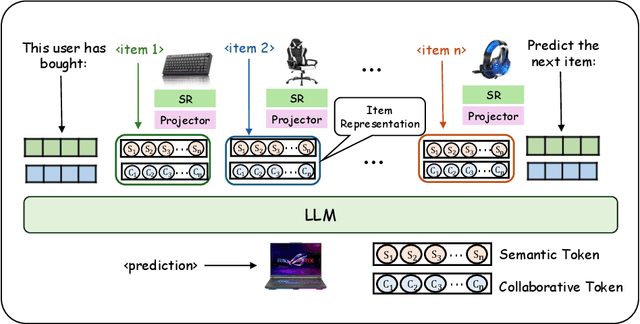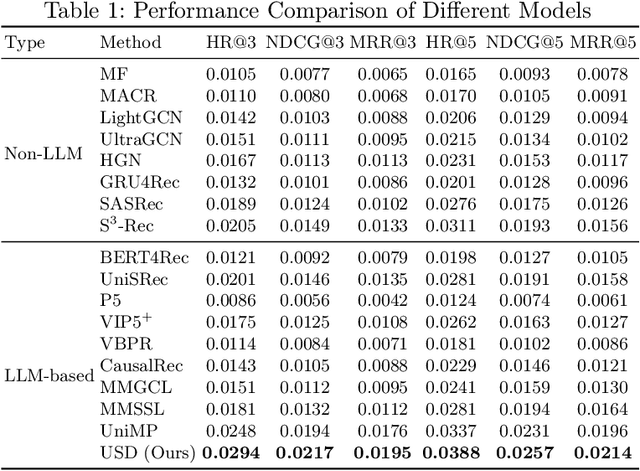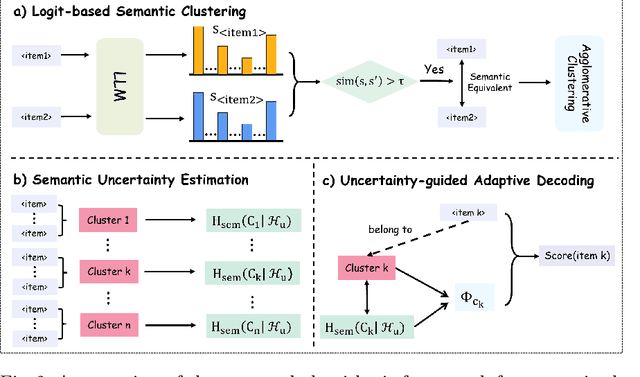Chong Zhang
Tony
Uncertainty-Aware Semantic Decoding for LLM-Based Sequential Recommendation
Aug 10, 2025



Abstract:Large language models have been widely applied to sequential recommendation tasks, yet during inference, they continue to rely on decoding strategies developed for natural language processing. This creates a mismatch between text-generation objectives and recommendation next item selection objectives. This paper addresses this limitation by proposing an Uncertainty-aware Semantic Decoding (USD) framework that combines logit-based clustering with adaptive scoring to improve next-item predictions. Our approach clusters items with similar logit vectors into semantic equivalence groups, then redistributes probability mass within these clusters and computes entropy across them to control item scoring and sampling temperature during recommendation inference. Experiments on Amazon Product datasets (six domains) gains of 18.5\% in HR@3, 11.9\% in NDCG@3, and 10.8\% in MRR@3 compared to state-of-the-art baselines. Hyperparameter analysis confirms the optimal parameters among various settings, and experiments on H\&M, and Netflix datasets indicate that the framework can adapt to differing recommendation domains. The experimental results confirm that integrating semantic clustering and uncertainty assessment yields more reliable and accurate recommendations.
Revisiting Adversarial Patch Defenses on Object Detectors: Unified Evaluation, Large-Scale Dataset, and New Insights
Aug 01, 2025



Abstract:Developing reliable defenses against patch attacks on object detectors has attracted increasing interest. However, we identify that existing defense evaluations lack a unified and comprehensive framework, resulting in inconsistent and incomplete assessments of current methods. To address this issue, we revisit 11 representative defenses and present the first patch defense benchmark, involving 2 attack goals, 13 patch attacks, 11 object detectors, and 4 diverse metrics. This leads to the large-scale adversarial patch dataset with 94 types of patches and 94,000 images. Our comprehensive analyses reveal new insights: (1) The difficulty in defending against naturalistic patches lies in the data distribution, rather than the commonly believed high frequencies. Our new dataset with diverse patch distributions can be used to improve existing defenses by 15.09% AP@0.5. (2) The average precision of the attacked object, rather than the commonly pursued patch detection accuracy, shows high consistency with defense performance. (3) Adaptive attacks can substantially bypass existing defenses, and defenses with complex/stochastic models or universal patch properties are relatively robust. We hope that our analyses will serve as guidance on properly evaluating patch attacks/defenses and advancing their design. Code and dataset are available at https://github.com/Gandolfczjh/APDE, where we will keep integrating new attacks/defenses.
Next Tokens Denoising for Speech Synthesis
Jul 30, 2025Abstract:While diffusion and autoregressive (AR) models have significantly advanced generative modeling, they each present distinct limitations. AR models, which rely on causal attention, cannot exploit future context and suffer from slow generation speeds. Conversely, diffusion models struggle with key-value (KV) caching. To overcome these challenges, we introduce Dragon-FM, a novel text-to-speech (TTS) design that unifies AR and flow-matching. This model processes 48 kHz audio codec tokens in chunks at a compact 12.5 tokens per second rate. This design enables AR modeling across chunks, ensuring global coherence, while parallel flow-matching within chunks facilitates fast iterative denoising. Consequently, the proposed model can utilize KV-cache across chunks and incorporate future context within each chunk. Furthermore, it bridges continuous and discrete feature modeling, demonstrating that continuous AR flow-matching can predict discrete tokens with finite scalar quantizers. This efficient codec and fast chunk-autoregressive architecture also makes the proposed model particularly effective for generating extended content. Experiment for demos of our work} on podcast datasets demonstrate its capability to efficiently generate high-quality zero-shot podcasts.
A Novel ViDAR Device With Visual Inertial Encoder Odometry and Reinforcement Learning-Based Active SLAM Method
Jun 16, 2025Abstract:In the field of multi-sensor fusion for simultaneous localization and mapping (SLAM), monocular cameras and IMUs are widely used to build simple and effective visual-inertial systems. However, limited research has explored the integration of motor-encoder devices to enhance SLAM performance. By incorporating such devices, it is possible to significantly improve active capability and field of view (FOV) with minimal additional cost and structural complexity. This paper proposes a novel visual-inertial-encoder tightly coupled odometry (VIEO) based on a ViDAR (Video Detection and Ranging) device. A ViDAR calibration method is introduced to ensure accurate initialization for VIEO. In addition, a platform motion decoupled active SLAM method based on deep reinforcement learning (DRL) is proposed. Experimental data demonstrate that the proposed ViDAR and the VIEO algorithm significantly increase cross-frame co-visibility relationships compared to its corresponding visual-inertial odometry (VIO) algorithm, improving state estimation accuracy. Additionally, the DRL-based active SLAM algorithm, with the ability to decouple from platform motion, can increase the diversity weight of the feature points and further enhance the VIEO algorithm's performance. The proposed methodology sheds fresh insights into both the updated platform design and decoupled approach of active SLAM systems in complex environments.
* 12 pages, 13 figures
Attention-Based Map Encoding for Learning Generalized Legged Locomotion
Jun 11, 2025Abstract:Dynamic locomotion of legged robots is a critical yet challenging topic in expanding the operational range of mobile robots. It requires precise planning when possible footholds are sparse, robustness against uncertainties and disturbances, and generalizability across diverse terrains. While traditional model-based controllers excel at planning on complex terrains, they struggle with real-world uncertainties. Learning-based controllers offer robustness to such uncertainties but often lack precision on terrains with sparse steppable areas. Hybrid methods achieve enhanced robustness on sparse terrains by combining both methods but are computationally demanding and constrained by the inherent limitations of model-based planners. To achieve generalized legged locomotion on diverse terrains while preserving the robustness of learning-based controllers, this paper proposes to learn an attention-based map encoding conditioned on robot proprioception, which is trained as part of the end-to-end controller using reinforcement learning. We show that the network learns to focus on steppable areas for future footholds when the robot dynamically navigates diverse and challenging terrains. We synthesize behaviors that exhibit robustness against uncertainties while enabling precise and agile traversal of sparse terrains. Additionally, our method offers a way to interpret the topographical perception of a neural network. We have trained two controllers for a 12-DoF quadrupedal robot and a 23-DoF humanoid robot respectively and tested the resulting controllers in the real world under various challenging indoor and outdoor scenarios, including ones unseen during training.
OmniDRCA: Parallel Speech-Text Foundation Model via Dual-Resolution Speech Representations and Contrastive Alignment
Jun 11, 2025Abstract:Recent studies on end-to-end speech generation with large language models (LLMs) have attracted significant community attention, with multiple works extending text-based LLMs to generate discrete speech tokens. Existing approaches primarily fall into two categories: (1) Methods that generate discrete speech tokens independently without incorporating them into the LLM's autoregressive process, resulting in text generation being unaware of concurrent speech synthesis. (2) Models that generate interleaved or parallel speech-text tokens through joint autoregressive modeling, enabling mutual modality awareness during generation. This paper presents OmniDRCA, a parallel speech-text foundation model based on joint autoregressive modeling, featuring dual-resolution speech representations and contrastive cross-modal alignment. Our approach processes speech and text representations in parallel while enhancing audio comprehension through contrastive alignment. Experimental results on Spoken Question Answering benchmarks demonstrate that OmniDRCA establishes new state-of-the-art (SOTA) performance among parallel joint speech-text modeling based foundation models, and achieves competitive performance compared to interleaved models. Additionally, we explore the potential of extending the framework to full-duplex conversational scenarios.
Plug-and-Play Co-Occurring Face Attention for Robust Audio-Visual Speaker Extraction
May 27, 2025Abstract:Audio-visual speaker extraction isolates a target speaker's speech from a mixture speech signal conditioned on a visual cue, typically using the target speaker's face recording. However, in real-world scenarios, other co-occurring faces are often present on-screen, providing valuable speaker activity cues in the scene. In this work, we introduce a plug-and-play inter-speaker attention module to process these flexible numbers of co-occurring faces, allowing for more accurate speaker extraction in complex multi-person environments. We integrate our module into two prominent models: the AV-DPRNN and the state-of-the-art AV-TFGridNet. Extensive experiments on diverse datasets, including the highly overlapped VoxCeleb2 and sparsely overlapped MISP, demonstrate that our approach consistently outperforms baselines. Furthermore, cross-dataset evaluations on LRS2 and LRS3 confirm the robustness and generalizability of our method.
Invisible Prompts, Visible Threats: Malicious Font Injection in External Resources for Large Language Models
May 22, 2025Abstract:Large Language Models (LLMs) are increasingly equipped with capabilities of real-time web search and integrated with protocols like Model Context Protocol (MCP). This extension could introduce new security vulnerabilities. We present a systematic investigation of LLM vulnerabilities to hidden adversarial prompts through malicious font injection in external resources like webpages, where attackers manipulate code-to-glyph mapping to inject deceptive content which are invisible to users. We evaluate two critical attack scenarios: (1) "malicious content relay" and (2) "sensitive data leakage" through MCP-enabled tools. Our experiments reveal that indirect prompts with injected malicious font can bypass LLM safety mechanisms through external resources, achieving varying success rates based on data sensitivity and prompt design. Our research underscores the urgent need for enhanced security measures in LLM deployments when processing external content.
100 Days After DeepSeek-R1: A Survey on Replication Studies and More Directions for Reasoning Language Models
May 01, 2025Abstract:The recent development of reasoning language models (RLMs) represents a novel evolution in large language models. In particular, the recent release of DeepSeek-R1 has generated widespread social impact and sparked enthusiasm in the research community for exploring the explicit reasoning paradigm of language models. However, the implementation details of the released models have not been fully open-sourced by DeepSeek, including DeepSeek-R1-Zero, DeepSeek-R1, and the distilled small models. As a result, many replication studies have emerged aiming to reproduce the strong performance achieved by DeepSeek-R1, reaching comparable performance through similar training procedures and fully open-source data resources. These works have investigated feasible strategies for supervised fine-tuning (SFT) and reinforcement learning from verifiable rewards (RLVR), focusing on data preparation and method design, yielding various valuable insights. In this report, we provide a summary of recent replication studies to inspire future research. We primarily focus on SFT and RLVR as two main directions, introducing the details for data construction, method design and training procedure of current replication studies. Moreover, we conclude key findings from the implementation details and experimental results reported by these studies, anticipating to inspire future research. We also discuss additional techniques of enhancing RLMs, highlighting the potential of expanding the application scope of these models, and discussing the challenges in development. By this survey, we aim to help researchers and developers of RLMs stay updated with the latest advancements, and seek to inspire new ideas to further enhance RLMs.
SegOTA: Accelerating Over-the-Air Federated Learning with Segmented Transmission
Apr 13, 2025Abstract:Federated learning (FL) with over-the-air computation efficiently utilizes the communication resources, but it can still experience significant latency when each device transmits a large number of model parameters to the server. This paper proposes the Segmented Over-The-Air (SegOTA) method for FL, which reduces latency by partitioning devices into groups and letting each group transmit only one segment of the model parameters in each communication round. Considering a multi-antenna server, we model the SegOTA transmission and reception process to establish an upper bound on the expected model learning optimality gap. We minimize this upper bound, by formulating the per-round online optimization of device grouping and joint transmit-receive beamforming, for which we derive efficient closed-form solutions. Simulation results show that our proposed SegOTA substantially outperforms the conventional full-model OTA approach and other common alternatives.
 Add to Chrome
Add to Chrome Add to Firefox
Add to Firefox Add to Edge
Add to Edge